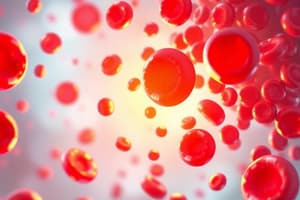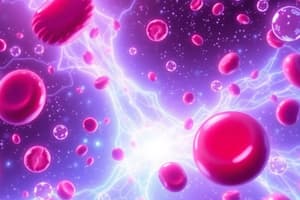Podcast
Questions and Answers
Which of the following is NOT a characteristic of HIT Type I?
Which of the following is NOT a characteristic of HIT Type I?
- It is an immune-mediated disorder. (correct)
- The platelet count typically returns to normal with discontinued heparin administration.
- It typically occurs within the first two days of heparin exposure.
- It is a mild, transient drop in platelet count.
Which type of heparin is more likely to cause HIT?
Which type of heparin is more likely to cause HIT?
- Neither heparin type causes HIT.
- Low molecular weight heparin (LMWH)
- Both are equally likely to cause HIT.
- Unfractionated heparin (UFH) (correct)
What is the typical onset time for HIT Type II?
What is the typical onset time for HIT Type II?
- 1-3 weeks after starting heparin therapy.
- 5-14 days after starting heparin therapy. (correct)
- Within 24 hours of starting heparin.
- More than 3 weeks after starting heparin therapy.
Which of the following is a life-threatening complication associated with HIT?
Which of the following is a life-threatening complication associated with HIT?
What are the diagnostic tests for HIT?
What are the diagnostic tests for HIT?
What is the first line treatment for HIT?
What is the first line treatment for HIT?
What is the normal range for platelet count in a healthy individual?
What is the normal range for platelet count in a healthy individual?
Which of the following is TRUE regarding HIT type II?
Which of the following is TRUE regarding HIT type II?
Which of the following is NOT considered a side effect of heparin?
Which of the following is NOT considered a side effect of heparin?
What is the primary mechanism of action of heparin in preventing blood clots?
What is the primary mechanism of action of heparin in preventing blood clots?
In the context of HIT, what does the term "procoagulant" mean?
In the context of HIT, what does the term "procoagulant" mean?
Why is a decrease in platelet count a cause for concern in a patient receiving heparin?
Why is a decrease in platelet count a cause for concern in a patient receiving heparin?
What is the typical threshold for suspecting HIT in a patient receiving heparin?
What is the typical threshold for suspecting HIT in a patient receiving heparin?
In patients with HIT, what typically happens to the size of existing thrombi?
In patients with HIT, what typically happens to the size of existing thrombi?
Which of the following correctly describes the role of heparin in the treatment of thrombotic events?
Which of the following correctly describes the role of heparin in the treatment of thrombotic events?
What is recommended for patients experiencing HIT?
What is recommended for patients experiencing HIT?
What is the primary mechanism by which heparin-induced thrombocytopenia (HIT) leads to thrombocytopenia?
What is the primary mechanism by which heparin-induced thrombocytopenia (HIT) leads to thrombocytopenia?
Which of the following clinical manifestations is NOT typically associated with HIT?
Which of the following clinical manifestations is NOT typically associated with HIT?
What is the role of platelet factor 4 (PF4) in the pathogenesis of HIT?
What is the role of platelet factor 4 (PF4) in the pathogenesis of HIT?
Which of the following statements accurately describes the anti-PF4 test?
Which of the following statements accurately describes the anti-PF4 test?
Why is the serotonin release assay considered more definitive than the anti-PF4 test in diagnosing HIT?
Why is the serotonin release assay considered more definitive than the anti-PF4 test in diagnosing HIT?
Which of the following accurately describes the pathogenesis of delayed-onset HIT?
Which of the following accurately describes the pathogenesis of delayed-onset HIT?
What is the potential consequence of the circulating immune complex (CIC) formed in HIT?
What is the potential consequence of the circulating immune complex (CIC) formed in HIT?
Which of the following complications is LEAST likely to arise from HIT?
Which of the following complications is LEAST likely to arise from HIT?
Flashcards
Heparin
Heparin
An anticoagulant that activates antithrombin III to inactivate thrombin and factor Xa, preventing blood clots.
Thrombocytopenia
Thrombocytopenia
A condition characterized by a decreased number of platelets (thrombocytes) in the blood.
Heparin-Induced Thrombocytopenia (HIT)
Heparin-Induced Thrombocytopenia (HIT)
A complication of heparin treatment that causes a drop in platelet count, paradoxically increasing clot risk.
Pro-coagulant effect of Heparin
Pro-coagulant effect of Heparin
Signup and view all the flashcards
Activation of Antithrombin III
Activation of Antithrombin III
Signup and view all the flashcards
Monitoring Platelet Counts
Monitoring Platelet Counts
Signup and view all the flashcards
Heparin Replacing Anticoagulant
Heparin Replacing Anticoagulant
Signup and view all the flashcards
Common Uses of Heparin
Common Uses of Heparin
Signup and view all the flashcards
Type I HIT
Type I HIT
Signup and view all the flashcards
Type II HIT
Type II HIT
Signup and view all the flashcards
Heparin-PF4-IGg Complex
Heparin-PF4-IGg Complex
Signup and view all the flashcards
Clinical Scoring for HIT
Clinical Scoring for HIT
Signup and view all the flashcards
Diagnosis of HIT
Diagnosis of HIT
Signup and view all the flashcards
Alternative Anticoagulant
Alternative Anticoagulant
Signup and view all the flashcards
Serotonin Release Assay
Serotonin Release Assay
Signup and view all the flashcards
Delayed-onset HIT
Delayed-onset HIT
Signup and view all the flashcards
PF4 (Platelet Factor 4)
PF4 (Platelet Factor 4)
Signup and view all the flashcards
Immune complex formation
Immune complex formation
Signup and view all the flashcards
4T Score
4T Score
Signup and view all the flashcards
Complications of HIT
Complications of HIT
Signup and view all the flashcards
Study Notes
Heparin-Induced Thrombocytopenia (HIT)
- HIT is a life-threatening complication of heparin exposure.
- It occurs regardless of the dose, schedule, or route of administration.
- Heparin is given as unfractionated heparin (UFH) or low molecular weight (LMWH) heparin.
- HIT is more common with UFH than LMWH due to its greater immunogenic property and greater cross-reactivity with PF4.
- HIT has two types:
- Type I (non-immune): A mild, transient drop in platelets occurring within the first two days of heparin exposure.
- Type II (immune-mediated): An immune disorder occurring 5-14 days after heparin exposure. It has life-threatening thrombotic complications.
HIT Type 2: Rapid, Typical, and Delayed Onset
- Typical HIT: Onset of HIT occurs 5-14 days after heparin therapy begins.
- Rapid-onset HIT: Can occur in patients with prior heparin exposure within the last 100 days; platelet count drops within 24 hours of starting heparin.
- Delayed-onset HIT: Patients develop HIT and present with thrombosis and thrombocytopenia up to 3 weeks after heparin therapy ends.
HIT Diagnosis: 4T Score
- 4T score: A clinical scoring system used to diagnose HIT.
- It assesses four characteristics: thrombocytopenia, timing of platelet count fall, thrombosis or other sequelae, and other causes of thrombocytopenia.
- Thrombocytopenia: Decrease in platelet count over 50% and a platelet count of at least 20 x 109/L.
- Timing: Clear onset of platelet fall between days 5-14; and platelet fall within one day of starting heparin if heparin had been given in the past 30 days.
- Thrombosis or other sequelae: New thrombosis; skin necrosis at heparin injection sites, and anaphylactic reaction following intravenous heparin bolus.
- Other causes: No apparent other causes of thrombocytopenia
Diagnostic Assays
- Anti-PF4 test: Immunological test detecting IgG antibodies against the PF4/heparin complex.
- Serotonin Release Assay: Functional assay measuring heparin-dependent platelet activation. It's a more definitive test than the anti-PF4 test and a better predictor of thrombosis.
Clinical Manifestations
- Clinical manifestation:
- Hypercoagulable state: A tendency to form blood clots more easily.
- Thrombocytopenia: Decreased number of platelets.
- Complications:
- Deep vein thrombosis (DVT)
- Pulmonary embolism (PE)
- Myocardial infarction (MI)
- Limb artery occlusion
- Transient ischemic attack (TIA) or stroke
- Skin necrosis
- End-organ damage (adrenal, bowel, spleen, gallbladder, or hepatic infarction, renal failure)
- Death
Pathophysiology
- Heparin binds to platelet factor 4 (PF4) exposing a hidden immune epitope.
- Formation of the heparin-PF4 complex triggers the production of immunoglobulin G (IgG) antibodies.
- Premature thrombocyte clearance leads to thrombocytopenia.
- Antibody binding to the heparin-PF4 complex forms circulating immune complexes (CICs).
- CIC binding on FC-receptors on platelets triggers platelet activation and aggregation, thrombosis, and hypercoagulability.
- Platelet activation also leads to further PF4 release.
Studying That Suits You
Use AI to generate personalized quizzes and flashcards to suit your learning preferences.





